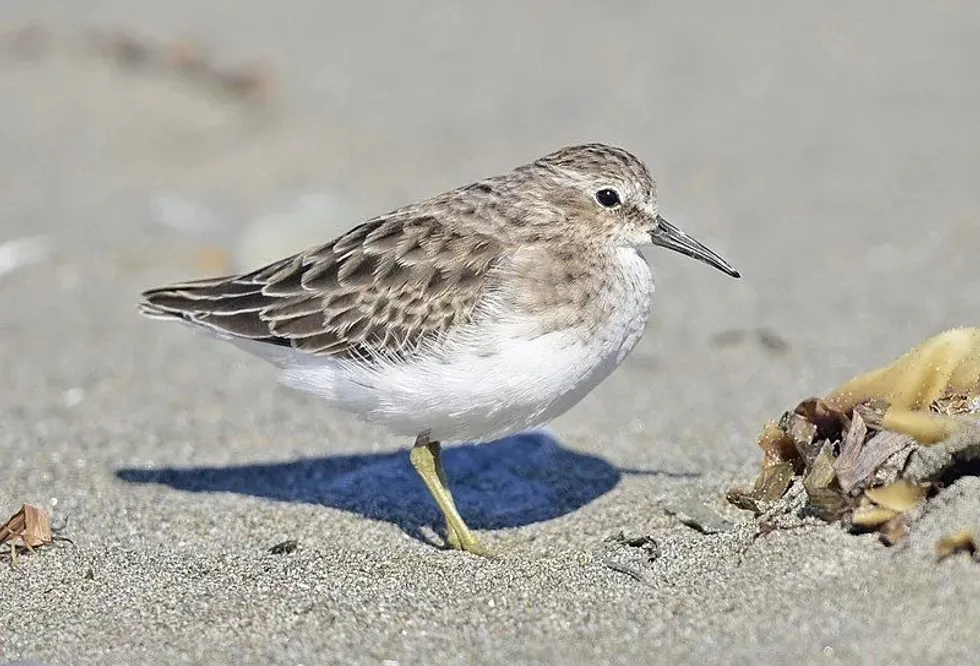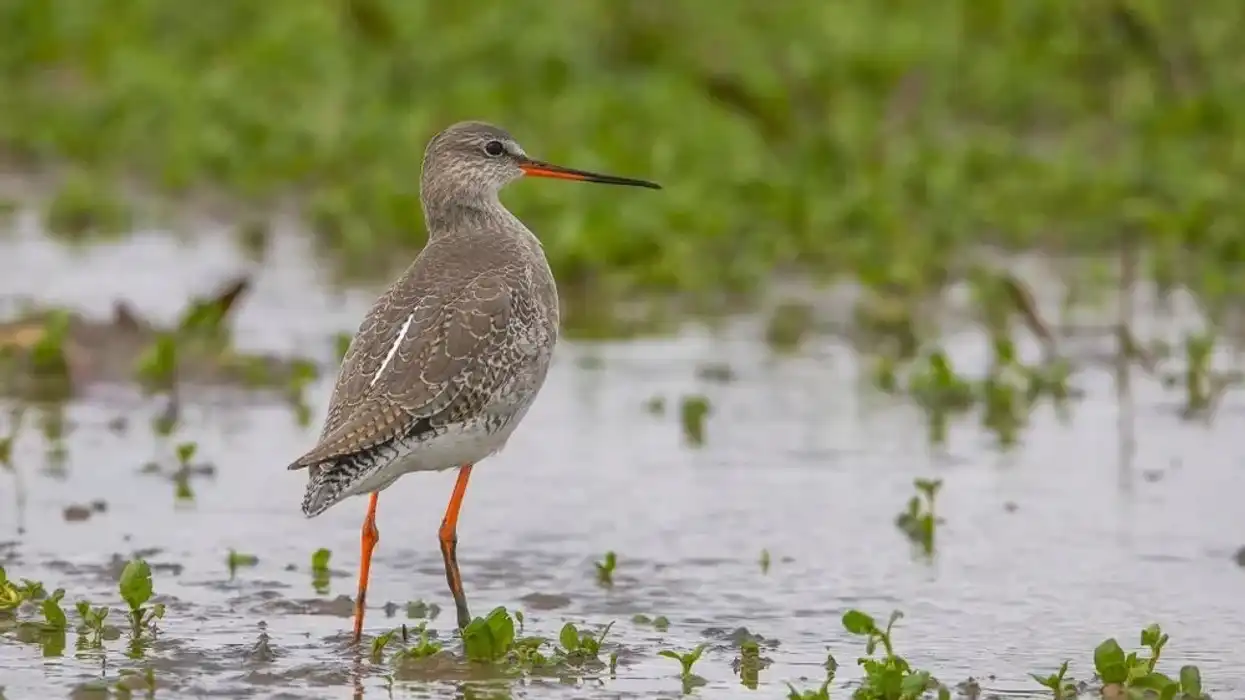The Least Sandpiper, Calidris minutilla as it is scientifically known, belongs to the Scolopacidae family. It is the smallest shorebird in the world.
Commonly, it is found in the southern United States and northern South America, and North America. The habitat of this bird includes boreal forests, meadows, coastal mudflats, rocky shorelines, and sandy beaches.
The Least Sandpiper diet includes insects, amphipods, and isopods and buried prey by probing mudflats. The breeding grounds are mostly in Tundra and forests in regions of North America.
It is believed that males arrive at the breeding grounds late and breeding pairs are formed. Both the males and females incubate the eggs in the nest and the juvenile Least Sandpiper or young one is capable of feeding itself.
The Least Sandpiper beak is thin, long, and dark and is known to have a shorter neck, brown breast, and short toes.
The adults tend to have dark streaks while the young are slightly brightly colored. Migration happens among these birds and these birds tend to travel long distances nonstop.
A young is fed even during migration or wintering by the parents. While there exist some similar species, all are slightly different and could be identified by certain features and flight.
The Least Sandpiper, Calidris minutilla as it is scientifically known, have not been domesticated in any way and are highly wild birds. These birds are small but there is a long list of interesting things to learn about them so keep reading, and if you are interested, read about the Nicobar pigeon and laughing gull too.
Least Sandpiper Interesting Facts
What type of animal is a Least Sandpiper?
The Least Sandpipers are birds.
What class of animal does a Least Sandpiper belong to?
This bird belongs to the class of Aves of birds.
How many Least Sandpipers are there in the world?
The total population of this bird is estimated to be 700,000.
Where does a Least Sandpiper live?
The Least Sandpiper range is found in extreme northern regions of North America. They may also live in Mexico and the Caribbean.
What is a Least Sandpiper's habitat?
These birds breed in the tundra and boreal forest. The nesting happens in coastal wetlands, bogs, meadows, and tussock heaths.
They also sometimes nest in sand dunes. During migration, they tend to be around coastal mudflats, rocky shorelines, and inland habitats including wet meadows and areas, flooded fields, and muddy edges of lakes, ponds, and ditches. The Least Sandpiper winter can be spent in parts of South America in mangrove forests, lagoons, wet ditches, swamps, and wet fields.
Who do Least Sandpipers live with?
These birds are found alone and in groups sometimes.
How long does a Least Sandpiper live?
This bird tends to live for about 12 years or more in the wild.
How do they reproduce?
These birds tend to breed in the northern part of North America in tundra or bogs. They nest on the ground near water.
The female lays around four eggs in scrapes covered or lined with grass and moss. Both parents tend to incubate the eggs but females tend to leave after some time the eggs hatch or even before that. The young are capable of feeding themselves and can fly within two weeks of birth.
What is their conservation status?
The conservation status of the Least Sandpipers is Least Concern. They are thought to have a stable population.
Least Sandpiper Fun Facts
What do Least Sandpipers look like?
Least Sandpipers have thin, long, and dark bills and greenish-yellowish legs. The breeding adults are brown with darker brown streaks on top and they are white underneath. They have a dark crown and light line above the eye.
In winter, these birds tend to be gray above. The young or the juveniles are bright patterned and white mantle stripes. These are known to have a shorter neck, brown breast, and shorter toes with dull colors.
How cute are they?
These birds are considered to be cute because of their somewhat shorter appearance.
How do they communicate?
During the breeding season, males display for females by very noisy callings and make fast circular flights with fast wingbeats and glide and then descent to the ground. They defend their display areas by fighting with other males, landing on their backs, sparring with their feet, and chase each other.
How big is a Least Sandpiper?
Sandpipers weigh around 0.042-0.066 lb (0.019-0.03 kg) and are 5.1-5.9 in (129-150 mm) long. They are very small Sandpipers.
How fast can a Least Sandpiper fly?
The exact speed of the flight of Least Sandpipers is unknown but the Sandpipers' wingspan is around 10.6-11 in (270-279 mm).
How much does a Least Sandpiper weigh?
Sandpipers weigh around 0.042-0.066 lb (0.019-0.03 kg).
What are their male and female names of the species?
There are no specific names for males and females of the species.
What would you call a baby Least Sandpiper?
While there is no specific name for a baby but in general, the juvenile birds are called chicks.
What do they eat?
Least Sandpipers generally eat insects and other invertebrates. They forage in moist mudflats, sandy beaches, or openings in marsh vegetations.
The diet of small invertebrates includes amphipods, isopods, gastropods, water fleas, midges, flies, beetles, and dragonflies. They hunt the prey at the surface and explore damp mud for buried prey and food. Their diet also includes seeds of marsh grasses that include smartweed and panic grass.
Are they friendly?
It is only known that the Sandpipers have no adverse effects on humans but it is believed that these birds do not like interacting with humans.
Would they make a good pet?
Sandpipers have not been domesticated in any way and they would not make great pets as they are wild and in some places, it is illegal to capture these birds.
Did you know...
Female sandpipers have slightly larger bills than males.
Both the male and the female incubates the eggs. The males take a longer shift that is almost the whole day while females incubate during the evenings.
The breeding pair is considered to be monogamous and stays together until the female abandons the brood.
Many species are diurnal and active during the day but some are crepuscular or nocturnal.
Though this bird is the smallest shorebird in the world, it is known to be the migration powerhouse as it can sometimes travel 2500 mi nonstop while migrating.
Unlike other species of sandpipers, Least Sandpipers travel in flocks of tens to hundreds rather than in groups of thousands.
Least Sandpipers were first described in 1815 by Louis Jean Pierre Vieillot, a French ornithologist.
There are many collective nouns for a group of Sandpipers like a bind, contradiction, fling, hill, and time-step.
If you are thinking about the Least Sandpiper vs Semipalmated Sandpiper or the Least Sandpiper vs Western Sandpiper, the greenish-yellow legs of this smallest shorebird distinguish it from the other two who have black legs.
When in flight, this species displays a white stripe down its wing and white on the side of the tail. The underwings are also slightly darker than the Western and Semipalmated Sandpipers.
There are around 98 species of Sandpipers.
Killdeer are similar species in terms of the appearance of Least Sandpipers as these birds also have brown and white parts on the body.
How to tell a Least Sandpiper from a Spotted Sandpiper?
There are various differences between the two Sandpipers. The Least Sandpipers are smaller than the spotted ones.
These sandpipers have an intricately patterned back while the Spotted Sandpiper has plain brown backs. Spotted Sandpipers are seldom found in flocks whereas Least Sandpipers are found in flocks of tens to hundreds. Spotted Sandpipers have yellowish legs while Least Sandpipers have greenish-yellowish legs.
The food and diet of both species are similar. The habitat, breeding ground, and migration places are also similar for both the Sandpipers, and both are rarely found in West Europe.
Why does the Least Sandpiper migrate?
Migration usually happens when the ecological climate is not favorable for breeding, feeding, or raising the young. These birds migrate in flocks or groups to the Southern United States, Mexico, Central America, the Caribbean, and northern South America. Some migratory or wintering habitats are coastal and some inland.
Here at Kidadl, we have carefully created lots of interesting family-friendly animal facts for everyone to discover! Learn more about some other birds including Caspian tern, or robin.
You can even occupy yourself at home by drawing one on our least sandpiper coloring pages.










